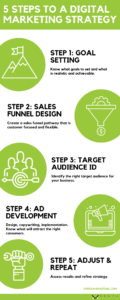Building a digital marketing strategy isn’t done overnight, nor is there a one size fits all plan. So strap on your seatbelt as we lay out the road map to composing a digital marketing strategy for you. To kick-off, digital marketing is a fluid business. Consumer habits change and so do effective digital tactics. The biggest piece of information to keep in mind is that when creating a digital marketing plan: don’t write it in ink.
The second biggest tidbit of advice, don’t be afraid of failure. Your marketing strategy doesn’t produce a final grade, it’s a working project that helps outline better future decisions. But before we break down the aspects of a digital marketing strategy, let’s identify what term means. Simply put, it’s the broad plan you govern by, in order to reach your desired goals. A digital marketing strategy is built around research, creative product, and implementation — with all three phases being equally important in the end goal: attracting consumers.
So now that we’ve got that all squared away, let’s look at the individual pieces you’re going to need to bring together in order to craft a fully-fledged marketing strategy.

Getting Started: Goal-Setting
You can’t successfully plan anything if you don’t know where you’re trying to go. From the outset, this phase is aimed at doing some in-depth soul searching.
- What is my end goal?
- What are my sub-goals?
- What timeline do I want to attach?
- What resources do I need?
- Are my goals realistic and achievable?
The goal-setting phase sets the tone for the rest of the marketing strategy. Write out in detail what you are trying to achieve and how you believe those goals can be met. This will lead to step number two: understanding your sales funnel.
Knowing Your Sales Funnel From Top To Bottom
At the end of the day, you’re probably trying to sell a good or service to your desired consumers. But making that happen involves the construction of a well-designed sales funnel. A misconception is that all sales funnels are linear: step 1, step 2, step 3, etc. Except, that isn’t the case. Many sales funnels must feature loops and switchbacks to former steps in order to properly win over a consumer. Today’s buyers are smarter than ever before. In addition, they are presented with more options than at any other time in history. These two factors call for sales funnels to be customer-focused and malleable.
When developing your funnel, think back to the questions you answered in your goal-setting process. How are the individual steps in your funnel going to support your goals? Just remember most sales are not done in a spirit, but a marathon.
Identifying Your Target Audience
This part is critical to seeing positive results with your digital marketing campaigns. Even with the right goals, the right sales funnel, and the right creative assets, your strategy will flop if the right consumer types are not identified. Marketing is half good product/service, and half connecting with the right audience. Therefore, in this phase, deep market research is needed. Questions must be answered and backed up by data.
- What does my ideal consumer look like?
- Who are my competitors targeting?
- Where do they live?
- How do they buy?
- When do they shop?
- What do they care about?
Proper audience identification isn’t easy, and more than likely it will evolve over time, but hitting the nail as close to the head as possible — is mandatory.
Get Creative: Developing Good Advertising
This is the part of a digital marketing strategy that most of us immediately think of — ads. Good design, copywriting, and placement can’t be overstated. Sometimes this portion of a strategy can make up for the lesser developed areas within the plan. But good ads go beyond catch headlines and pretty photoshop pictures. It involves knowing what advertising avenues fit with your customers and your ad types. Will SEO help meet your goals? Or is PPC a better tactic? What about programmatic advertising or influencer marketing?
Critical thinking is a key component to developing attractive, and effective, ads. Once you have ironed out the wrinkles in your design, messaging, and avenue channels, it’s time to launch your digital marketing strategy into the real world.
Last Step: Refine, Adjust & Repeat
At this point, all the research, planning, and creating is done. Your strategy is playing the game and results start to trickle in. You begin to assess, both micro and macro views of the strategy. What seems to work and what doesn’t… Now comes the hard part — being a chemist.
Like we mentioned at the start, a digital marketing strategy is fluid and ever-changing. Now is the time when you have to decide what to alter and what to keep. A-la-carte your strategy and begin to refine and adjust specific areas that are leading to high CPAs, poor close rates, slowed timelines, etc. Digital marketing, much like a sales funnel often isn’t a linear path, but instead a winding path to the finish line… and then you repeat the process.
